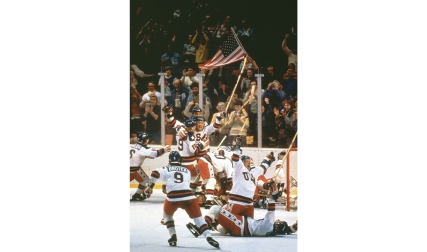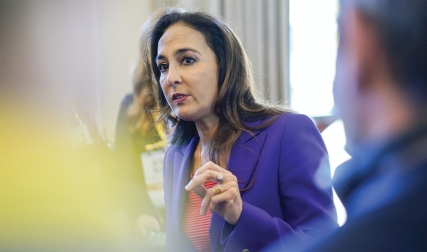Overtime
Your September/October issue [“100 Greatest Athletes”] is a delight. The athletic tradition at Dartmouth is worth celebrating, and you helped us properly celebrate. Each and every featured athlete is deserving and deserves the recognition. However, many of us noticed the omission of Mike Brown ’70. Mike was the No. 2 diver on our freshman team, complementing Don McAllister ’70, and the best diver in his class in the country. Mike, a two-time All-American, went on to win the 1-meter board at the NCAA championship and just missed making the U.S. Olympic team on the 10-meter platform.
This is not to call into question your judgment or your process in selecting the top 100. It is simply to recognize that Brown is the best athlete many of us in our era have ever known, at Dartmouth or elsewhere.
BILL RYAN ’70
Lake Lotawana, Missouri
Recognizing there are many candidates, here are a few you may have missed: Don
McKinnon ’63, a football lineman and first-team All-American who later played for the Boston Patriots; Nick Lowery ’78, a football kicker with an 18-year NFL career; and baseball player John “Chief” Meyers, class of 1909, a Native American whose fame came later as a catcher and who won three National League pennants with the New York Giants and played in four World Series.
Two others, very strong “all-league type” athletes who might be noted for other reasons, are Hank “The Hammer” Paulson ’68, a football lineman and later CEO of Goldman Sachs and secretary of the U.S. Department of the Treasury, and Buddy Teevens ’79, football quarterback and now Dartmouth’s head coach.
BOB SANNER ’67
Palo Alto, California
How could one possibly leave Willie Bogan ’71 (football) and James Brown ’73 (basketball) off the list?
RICHARD JONES ’75
Charlotte, North Carolina
I have to say I am extremely disappointed by this article. Given the sacrifice and overall achievements I earned playing squash while an undergraduate at Dartmouth, as well as those achieved after graduation playing professionally and for the U.S. men’s team, this list makes me feel marginalized, much like I did when I attended Dartmouth.
RYAN DONEGAN ’05
Mandeville, Louisiana
You excluded Don McKinnon ’63, an All-American football player who also played for the Boston Patriots and was an outstanding linebacker and center for the undefeated 1962 football team. He hiked the ball for Bill King ’63, who made the list—both belong there. Their team was the first to go undefeated since 1925, and it would not have were it not for McKinnon.
BILL WELLSTEAD ’63
Osprey, Florida
I expected to find Ralph Miller ’55 and Jake Crouthamel ’60 on the list.
SETH ZIMMERMAN ’60
Bellingham, Washington
I have been around sports long enough to know that choosing any list of the “greatest” is a fool’s errand. The committee has done good work, and one cannot quibble about the fact that all those chosen were great athletes, but the superlative “best” means that they all are better than some not on the list, to the detriment of those not mentioned.
Let me cite a few examples. First, during my Dartmouth years 1966-70, I was fortunate to see two great quarterbacks in Mickey Beard ’67 and Jim Chasey ’71. Both led teams that were undefeated Ivy League champs and both were Lambert trophy winners. Both were also tremendous shortstops on teams that went to regional NCAA playoffs. These were multi-sport talents, a gift not rated highly enough.
I would be remiss not to put in a plug about the absence of anyone on the 1970 baseball team that went to the College World Series and won the opening game behind Chuck Seelbach ’70, who certainly deserved mention with the other major league pitchers. Chuck became the closer for the Tigers in 1972. His career was cut short by injury, but in his only full year he pitched in 61 games with a 2.89 ERA. He was also an accomplished swimmer.
To see how cruel the list is, there is no space for Eddie Jeremiah ’30, who is in the U.S. Hockey Hall of Fame. At Dartmouth he lettered twice in football, twice in baseball, and three times in hockey. He went on to play with the Boston Bruins. He coached Dartmouth hockey from 1937 to 1967, and at one point his teams won 46 straight games.
Peter Rogol ’70, DMS’78
New Haven, Connecticut
Dartmouth was known (and sometimes mocked) as the “jock school” of the Ivy League when I attended in the early 1970s, and, based on DAM’s special issue on the College’s “100 Greatest Athletes,” that may be the case even today. In the interest of balance, may I suggest future issues on the College’s greatest scientists, authors, artists, business innovators, and public servants? After all, Dartmouth alumni have made notable contributions in many fields, not just athletics.
BILL DeJONG ’73
>Sudbury, Massachusetts
The September issue of the Alumni Magazine purports to identify the College’s 100 best athletes. I don’t know any of the selection committee members, but they failed us by not including Ed Leede ’48, who graduated as a class of 1949 member and led the basketball team from 1946 until 1949, before playing two years with the Boston Celtics and then securing an MBA from Harvard Business School and financing construction of Leede Arena.
Wrongly omitted also was Art Young ’46, football team starting guard and baseball team’s catcher, 1947-1949, who signed with the Cincinnati Reds and played one season in a minor league before coaching freshman football at the College, later assistant coach at Amherst College, and thereafter a successful businessman.
QUENTIN L. COPP ’49
San Francisco
The athletes you selected mostly had some post-graduate experience in a single sport.
You overlooked those athletes who excelled in multiple sports while in school. One of the best of this class is David Smoyer ’63, who earned nine letters in soccer, squash, and tennis while an undergraduate. He earned All-American honors as a soccer goalie.
DAVID McCOLLUM ’63
Rowayton, Connecticut
I found no reference to Dick Durrance ’39, who evidently is not one of Dartmouth’s greatest athletes, but nevertheless was considered, partly on the basis of 17 national championships, to be one of the country’s greatest skiers. With a miss of this magnitude, I wonder who else was omitted.
JAMES WATKINS ’84
Snowmass Village, Colorado
No Dick Durrance ’39 in top 15, let alone top 100? Amazing error. 17-time national champion, Olympian, and one of only two people to ski straight down Tuckerman’s Headwall. Wow, what a mistake.
JAMES DWINELL, Tu’70
Randolph, Vermont
Great issue! A lot of research time clearly went into this. And I’m sure you’ll get a lot of “what about?” emails. It reads like you were a little lazy with the entry on Ellen Remsen Webb ’80. She won the Kenneth Archibald Prize, and she captained the World Cup championship lacrosse team that you mentioned Sandy Bryan Weatherall ’83 was on.
COLLEEN SULLIVAN BARTLETT ’79
Santa Monica, California
The selection committee missed the goalposts in omitting Lowery from its list of Dartmouth’s 100 Greatest Athletes. As a kicker for the Kansas City Chiefs and New York Jets, Nick played in the NFL for 18 seasons. Between 1980 and 1998 he was the most accurate kicker in NFL history. He was selected to Sports Illustrated's NFL All-Decade Team of the 1980s and was the No. 2 kicker on its 1990s All-Decade Team, even though he didn't play after 1996. (He did lead the NFL in scoring in 1990.) Nick was a seven-time All-Pro, kicking game-winning points in three Pro Bowls. When he retired, he held the NFL record for most 50-yard field goals, and he still holds the record for most games with two 50-yard field goals. Happily, Nick is in the Kansas City Chiefs Hall of Fame.
It should be noted that Nick was also a starting pitcher for the Big Green baseball team
With all that, there are Nick’s philanthropic efforts. In 1993 he received the Justice Byron “Whizzer” White Award, the NFL Players Association’s highest humanitarian award, for his work with the Nick Lowery Youth Foundation, which he continues to the current day. Nick’s annual “Champions for the Homeless” event in Phoenix attracts many former NFLers to provide holiday meals for those in need.
BROOKS CLARK ’78
Knoxville, Tennessee
I was surprised and disappointed by the omission from the list of Dartmouth’s 100 greatest athletes of one of Big Green Football's most prolific scorers, Nick “The Kick” Lowery.
A quick snapshot of his career, from a 2011 DAM feature: Member, Kansas City Chiefs Hall of Fame; seven-time all pro; retired with NFL records for highest percentage and all-time field goals (383); 2010 nominee for Pro Football Hall of Fame; his “Kick with Nick” program raised more than $1 million to combat cerebral palsy; won NFL’s Byron “Whizzer” White Humanitarian Award, 1993. He also established the Lowery Youth Foundation, which focused on leadership training for Native youth, including a program at Dartmouth.
A lot of my fellow ’81s may also remember what I believe was our first Dartmouth home game as students, in the fall of ’77, when Nick drilled a field goal of over 40 yards with time running out to defeat Holy Cross. The student section went nuts. Over an 18-year NFL career with three teams, that scene would be repeated on a much greater scale, with a greatness first made evident in Memorial Stadium, in Cambridge, and in New Haven.
B. TUCKER GILMAN ’81
Los Angeles
You overlooked the great Lowery, one of the greatest place-kickers in NFL history, and the single greatest football player of any Dartmouth alumnus who ever played in the NFL. Among all NFL place-kickers whose careers ended in the 20th century, he ranks first in the number of field goals made (383) and first in field goal percentage (79.96%). He is a superior athlete to the majority of your Top 100 and may well belong in your Men’s Top 15 in lieu of any of the football players after the great Reggie Williams ’76.
JOHN GILBERTSON ’79
Lake Forest, Illinois
Food for Thought
It was a joyful experience for me to read about Chelsey Luger ’10 [“Earth Tones,” July/August] improving her own health and nutrition “one Collis visit at a time.” When I was hired to start the Collis Cafe in 1978, I longed to provide a place on campus where students and faculty could make healthy choices from our salad bar, homemade soups, and whole-grain baked goods. Teaching my student staff how to make omelettes, salad dressings, pastries, and soups, and how to grow sprouts was as much a part of my mission as feeding the campus. I still have the much-spilled-on copy of the Moosewood Cookbook we used daily. Within the first year, in our small original location above the campus police office, we were serving 2,000 customers a day.
Whenever I return to Hanover, it is delightful to see Collis crowded with students and faculty, even though there are now many great eateries both on and off campus. I’m grateful to have played a role in creating a place that students would think of when searching for comforting and healthy food and even remember as a significant part of their Dartmouth experience.
ROBBIN DERRY ’75
Calgary, Alberta
Temporary Insanity
I have read every issue of the DAM since I graduated. I have never been as shocked as when you published the pro-Putin letter [“A Putin Fan,” July/August]. There are plenty of letters you publish that I don’t agree with, generally by older alums. But this was insane. It was also very strange that you published this letter in the same issue that included a profile on a Ukrainian student.
LISA KIRCHER ’07
Loveland, Ohio
An 11th-Hour Plea
U.S. Senator Rob Portman ’78, who was treated as a heroic figure in the July/August 2021 issue of DAM, is entering his final months in office still not having stood up to Donald Trump and his “Big Lie” that the 2020 presidential election was stolen from him. Trump incited what was in essence a coup attempt on January 6, 2021, when his Proud Boys and Oath Keepers and other supporters stormed the U.S. Capitol Building with cries of “Hang Mike Pence,” causing several deaths and hundreds of injuries among the Capitol’s defenders. But because Portman and his Republican colleagues in the Senate refused to convict the former president, he remains an active threat to our democratic way of government.
I would like to make an 11th-hour plea to Sen. Portman, while he is still a senator, to stand up for what is right and denounce Trump for his refusal to accept the voters’ will, his continued efforts at voter suppression, and his promotion of Republican candidates committed to “re-electing” him in 2024 regardless of the vote count. Who knows? A show of political courage like that might inspire a few other Republican senators to do the same.
DAVID BERGENGREN ’68
Northampton, Massachusetts
Silent Treatment
After attending the 75th anniversary of the Dartmouth Aires in Hanover in mid-May, an event celebrating the oldest a cappella singing group at Dartmouth, one that brought more than 120 alumni singers back to the College for fellowship and singing events including a formal concert, I looked in vain for any mention of this event in the Alumni Magazine. All I saw was an ad paying tribute to all the a cappella groups at Dartmouth, one paid for by members of the Aires themselves. (Insert sad and perplexed emoji.)
ROBIN FELIX ’75
San Diego, California
Editor’s Note: The anniversary was noted in the July/August Campus section.
War of Words
Allan Ryan [“Continuing Ed,” July/August] needs a response. Noting that President Biden referred to what is going on in Ukraine as genocide, Ryan states that the acts are war crimes, not genocide, which is different than “simply” the killing of civilians. What is happening in Ukraine is genocide, based on the five attributes adopted by the United Nations in 1948. Ryan should be aware of this.
These acts include: killing members of the group (yes in Ukraine, targeted bombing/killing of non-combatants); causing serious bodily or mental harm to members of the group (yes in Ukraine, with thousands killed, millions displaced, 250,000-plus removed and imprisoned in Russia); deliberately inflicting on the group conditions of life calculated to bring about its physical destruction in whole or in part (yes, bombing non-military sites, destroying power stations, leaving Ukrainians starving); imposing measures intended to prevent births within the group (yes, displacement of entire populations, and separation of men and women), and forcibly transferring children of the group to another group (yes, thousands of Ukrainian children re-located to Russia).
So, yes, Russia is engaged in genocide in Ukraine, and Ryan is experienced enough to properly recognize it for genocide. I am disappointed that DAM did not question his statement.
JOHN BOYLE ’73
Emmaus, Pennsylvania
Architecture Sleuth
Thank you for that wonderful article “A Sense of Peace” by Kenneth Bryant, Adv’07, available on the magazine’s website. It was gripping reading and an excellent detective story.
LYLE NYBERG ’69
Scituate, Massachusetts
CORRECTION: In “Big Picture” [September/October], No. 15 of the Cincinnati Royals—the great Wayne Embry—was misidentified as the great Elgin Baylor. We regret the error.



